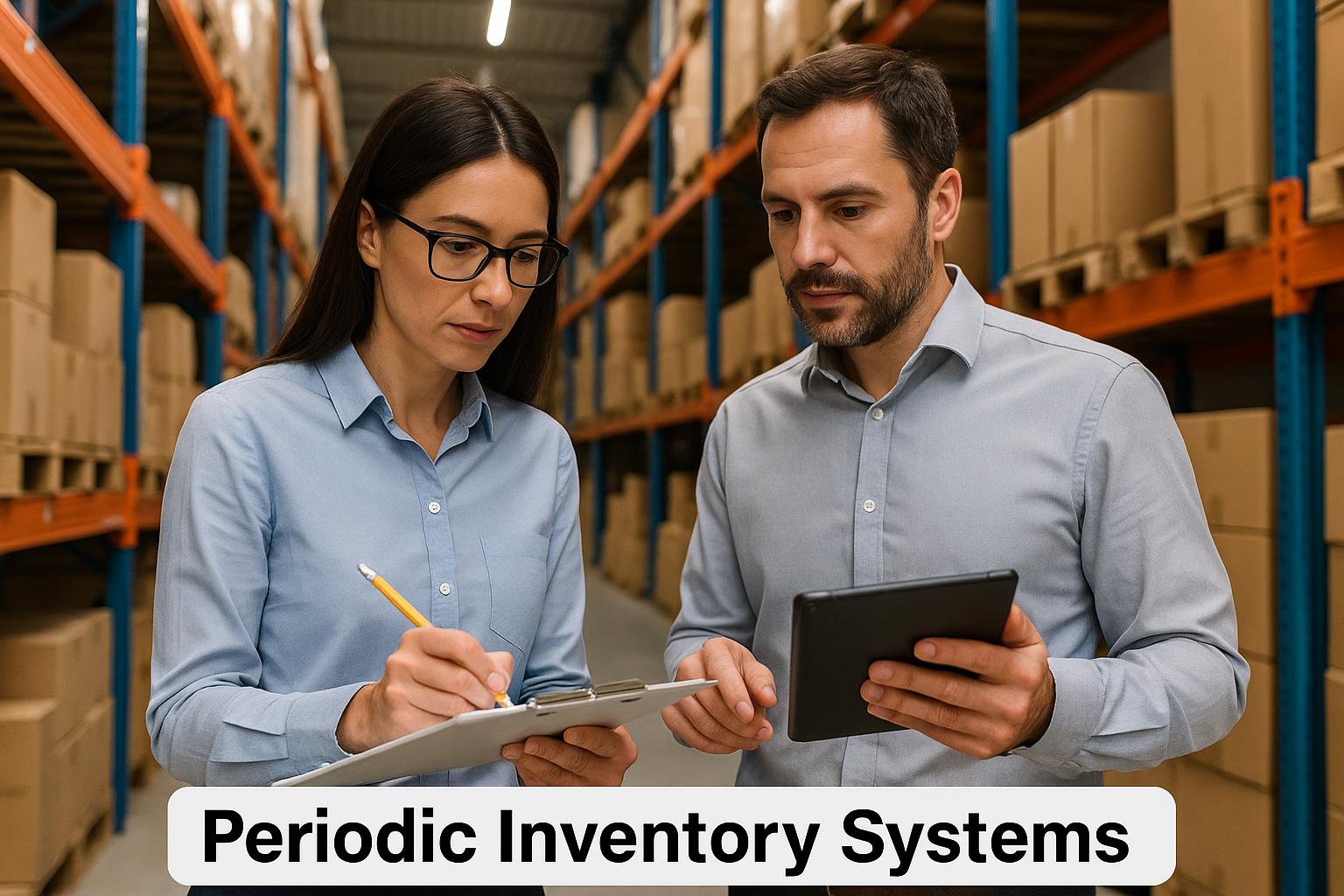Why Inventory Systems Matter
Every successful business — from retail stores to eCommerce brands — relies on accurate inventory tracking. Knowing what’s in stock, what’s sold, and what needs reordering keeps operations smooth and customers satisfied.
Two primary systems dominate inventory management: the perpetual inventory system and the periodic inventory system.
While perpetual systems use continuous tracking through software and barcode scanners, the periodic inventory system relies on scheduled updates — typically at the end of a day, week, month, or financial period.
Despite being less automated, the periodic system remains popular among small businesses, wholesalers, and organizations that don’t need real-time tracking.
This guide breaks down everything you need to know about periodic inventory systems — how they work, when to use them, their advantages, disadvantages, formulas, and modern-day applications.
1. What Is a Periodic Inventory System?
A Periodic Inventory System is an accounting method used to track inventory levels by physically counting stock at specific intervals — such as monthly, quarterly, or annually.
Unlike perpetual systems, where every sale and purchase updates inventory instantly, the periodic system records inventory data only at the end of a given period.
Key Concept:
Inventory quantities and costs are not updated continuously. Instead, businesses calculate:
- Cost of Goods Sold (COGS)
- Ending Inventory
after a physical count.
Example:
A small clothing retailer counts inventory every month. At month’s end, they determine how many items are left, compare it to purchases and sales, and calculate COGS using:
COGS = Beginning Inventory + Purchases – Ending Inventory
2. How the Periodic Inventory System Works
The process is simple, but timing and accuracy are critical.
Step-by-Step Process
- Beginning Inventory
- The amount of inventory available at the start of a period.
- Record Purchases
- During the period, all purchases are recorded in a Purchases Account, not directly in inventory.
- Physical Count
- At the end of the period, a physical count determines how much inventory remains.
- Calculate COGS
- Use the periodic formula to calculate Cost of Goods Sold.
- Adjust Inventory Account
- Adjust the general ledger to match the new ending inventory value.
This manual process makes it suitable for smaller operations with manageable stock volumes.
3. Periodic vs. Perpetual Inventory Systems
To understand the strengths of the periodic system, it helps to compare it with the perpetual system — its more modern counterpart.
| Feature | Periodic Inventory System | Perpetual Inventory System |
| Tracking Frequency | Periodic (weekly, monthly, yearly) | Continuous, in real time |
| Accuracy | Lower (depends on physical counts) | High |
| Technology | Minimal (manual or basic spreadsheets) | Requires software, scanners, POS integration |
| COGS Calculation | At end of period | Continuous |
| Best For | Small businesses, low-volume sales | Large businesses, high-volume sales |
| Cost | Lower setup and maintenance | Higher software and hardware costs |
In short:
- Periodic = Simplicity & Low Cost
- Perpetual = Accuracy & Real-Time Data
4. When to Use a Periodic Inventory System
A periodic system is best suited for companies where inventory volume is low, transactions are fewer, or cost-saving is a priority.
Ideal Scenarios
- Small retailers or local shops
- Wholesalers with bulk but infrequent orders
- Businesses with stable product lines
- Organizations transitioning to digital inventory systems
- Seasonal sellers who count inventory after busy periods
For these cases, a periodic system provides enough control without the overhead of complex technology.
5. Advantages of the Periodic Inventory System
Despite being older and less automated, this system offers several key benefits:
1. Lower Cost
No need for advanced inventory software or hardware like scanners or RFID tags. Ideal for businesses on a budget.
2. Simplicity
Easy to understand, set up, and maintain — even without accounting expertise.
3. Less Recordkeeping
Reduces daily administrative tasks; transactions are grouped rather than tracked individually.
4. Suitable for Stable Inventory
Perfect for businesses where stock levels don’t change rapidly.
5. Better for Manual Operations
Great for small shops that rely on spreadsheets or physical ledgers.
6. Disadvantages of the Periodic Inventory System
While simple, the periodic method comes with trade-offs that can impact business decisions.
1. Lack of Real-Time Data
You only know your true inventory level at the end of a period — which can lead to stockouts or overstocking.
2. Inaccurate COGS During Period
Since COGS is calculated only after the count, financial statements during the period may be misleading.
3. High Risk of Human Error
Manual counting and recording are prone to mistakes.
4. Difficult for Large Businesses
As product variety and volume increase, periodic counting becomes impractical.
5. Cannot Track Shrinkage or Theft in Real Time
Any lost, stolen, or damaged items are only discovered at the next inventory count.
7. The Periodic Inventory Formula
The core formula for calculating Cost of Goods Sold (COGS) under a periodic system is:
COGS = Beginning Inventory + Purchases – Ending Inventory
Example:
A store starts the month with $10,000 in inventory, purchases $5,000 worth of goods, and ends with $8,000 in stock.
COGS = $10,000 + $5,000 – $8,000 = $7,000
That $7,000 represents the total cost of goods sold during the month.
8. Inventory Valuation Methods in Periodic Systems
Periodic systems can use several valuation methods to determine the cost of ending inventory and COGS.
1. FIFO (First-In, First-Out)
Assumes oldest inventory is sold first.
- Ending inventory = most recent purchases.
- Works well in rising cost environments.
2. LIFO (Last-In, First-Out)
Assumes newest inventory is sold first.
- Ending inventory = oldest costs.
- Often used for tax benefits in inflationary periods.
3. Weighted Average Cost
Averages all purchase costs during the period.
- Smooths price fluctuations.
- Common in wholesale or bulk purchase industries.
These valuation methods ensure consistency and compliance in financial reporting.
9. Journal Entries in a Periodic Inventory System
Unlike perpetual systems, which record transactions continuously, periodic systems use temporary accounts.
Typical Journal Entries
- Recording Purchases
- Debit: Purchases
- Credit: Accounts Payable or Cash
- Recording Sales
- Debit: Accounts Receivable or Cash
- Credit: Sales Revenue
- Adjusting Inventory (at Period End)
- Debit: Inventory (Ending Balance)
- Debit: COGS
- Credit: Purchases
- Credit: Inventory (Beginning Balance)
This ensures accurate financial statements after each count period.
10. Periodic Inventory System Example (Step-by-Step)
Let’s consider a detailed example:
Example: “Bright Shoes Co.”
- Beginning Inventory: $25,000
- Purchases During Month: $15,000
- Ending Inventory (after physical count): $20,000
Step 1: Calculate COGS
COGS = $25,000 + $15,000 – $20,000 = $20,000
Step 2: Adjust Accounts
- Record purchases throughout the month in the Purchases account.
- After counting, update the Inventory account to show $20,000.
- Transfer COGS to the income statement.
Step 3: Analyze
Bright Shoes Co. sold $20,000 worth of inventory this month — which helps in pricing and profitability analysis.
11. Technology’s Role in Modern Periodic Systems
Even though periodic systems are traditionally manual, many businesses now use digital tools to streamline them.
Modern Enhancements Include:
- Spreadsheet templates (Excel, Google Sheets) for tracking counts and calculations.
- Basic inventory management software that supports periodic counting.
- Barcode scanners used only during count periods.
- Integration with accounting tools like QuickBooks or Xero.
Some 3PL providers, such as Max 3PL, even help clients perform periodic counts within their warehouses — blending traditional methods with digital tracking.
12. Advantages of Combining Periodic Systems with 3PL Fulfillment
Modern 3PLs (Third-Party Logistics providers) can make periodic systems more efficient.
How Max 3PL Enhances Periodic Inventory
- Conducts scheduled inventory audits.
- Provides detailed stock reports to clients.
- Uses barcode scanning and SKU tracking during counts.
- Helps reconcile discrepancies automatically.
- Maintains data transparency for accounting purposes.
This hybrid approach offers accuracy without complexity — ideal for growing businesses transitioning toward more automated systems.
13. Limitations and Risks
Even with improvements, the periodic inventory system has limitations:
- Limited control over fast-moving inventory.
- Difficult to detect losses or theft quickly.
- Potential delays in financial reporting.
- Not suitable for real-time online sales platforms.
As your business grows, it’s often necessary to transition to a perpetual system for better oversight.
14. Transitioning from Periodic to Perpetual Systems
Many companies start with periodic systems, then upgrade as they scale.
Transition Steps:
- Implement barcode or RFID technology.
- Integrate POS (Point-of-Sale) systems for real-time updates.
- Choose a cloud-based inventory platform.
- Conduct an initial physical count for baseline accuracy.
- Train staff and monitor data accuracy over time.
Providers like Max 3PL can assist in migrating from manual counting to automated, real-time inventory systems.
15. Real-World Applications of Periodic Systems
Despite automation, many industries still use periodic inventory tracking — especially where cost control or simplicity is key.
Industries Using Periodic Inventory:
- Local retail stores and boutiques
- Wholesale distributors
- Seasonal businesses (e.g., holiday retailers)
- Small manufacturers
- Service-based businesses with low material usage
For these companies, the periodic method remains a practical solution.
16. Key Performance Metrics to Track
Even under a periodic system, businesses should monitor inventory efficiency and financial performance.
Important Metrics Include:
- Inventory Turnover Ratio
(COGS ÷ Average Inventory) - Gross Margin Return on Investment (GMROI)
- Stockout Rate
- Shrinkage Rate
- Days Sales of Inventory (DSI)
These indicators reveal how efficiently a company manages its stock and capital.
17. Common Mistakes to Avoid
Periodic systems are simple but prone to certain errors.
Mistakes Include:
- Counting errors or missed items.
- Not reconciling purchase invoices.
- Ignoring damaged or returned goods.
- Poor documentation.
- Failing to update software or ledgers regularly.
Routine audits and organized records can prevent costly discrepancies.
18. Benefits of Periodic Counts for Audit and Tax Purposes
Regular physical counts help ensure compliance and accuracy for financial reporting.
- Auditors can verify inventory balances.
- Businesses can detect theft or waste.
- Tax deductions (e.g., cost of goods sold) are easier to substantiate.
Periodic systems, when managed properly, strengthen transparency and accountability.
19. The Future of Inventory Tracking
While perpetual systems dominate in automation, hybrid inventory models are emerging — combining real-time tracking with scheduled audits for added accuracy.
AI, IoT sensors, and warehouse management platforms now make it easier to track even manual inventory processes efficiently.
In this evolving landscape, periodic systems continue to serve as a foundation for smaller operations and a backup method for larger ones.
The Role of Periodic Inventory in Modern Business
The Periodic Inventory System may be one of the oldest accounting methods, but it remains relevant — particularly for businesses focused on simplicity, cost savings, and manual operations.
While it lacks the precision and real-time data of perpetual systems, it provides a clear and affordable snapshot of inventory and financial performance.
For businesses just starting out or managing smaller product lines, the periodic method offers control without the complexity of expensive software.
And with modern tools and 3PL partners like Max 3PL, companies can enhance accuracy, automate parts of the process, and even prepare for a future transition to real-time tracking.
Ultimately, success isn’t about the system itself — it’s about how well you manage it. Whether periodic or perpetual, consistent auditing, good data discipline, and reliable partnerships are what keep your supply chain — and your profits — running smoothly.








